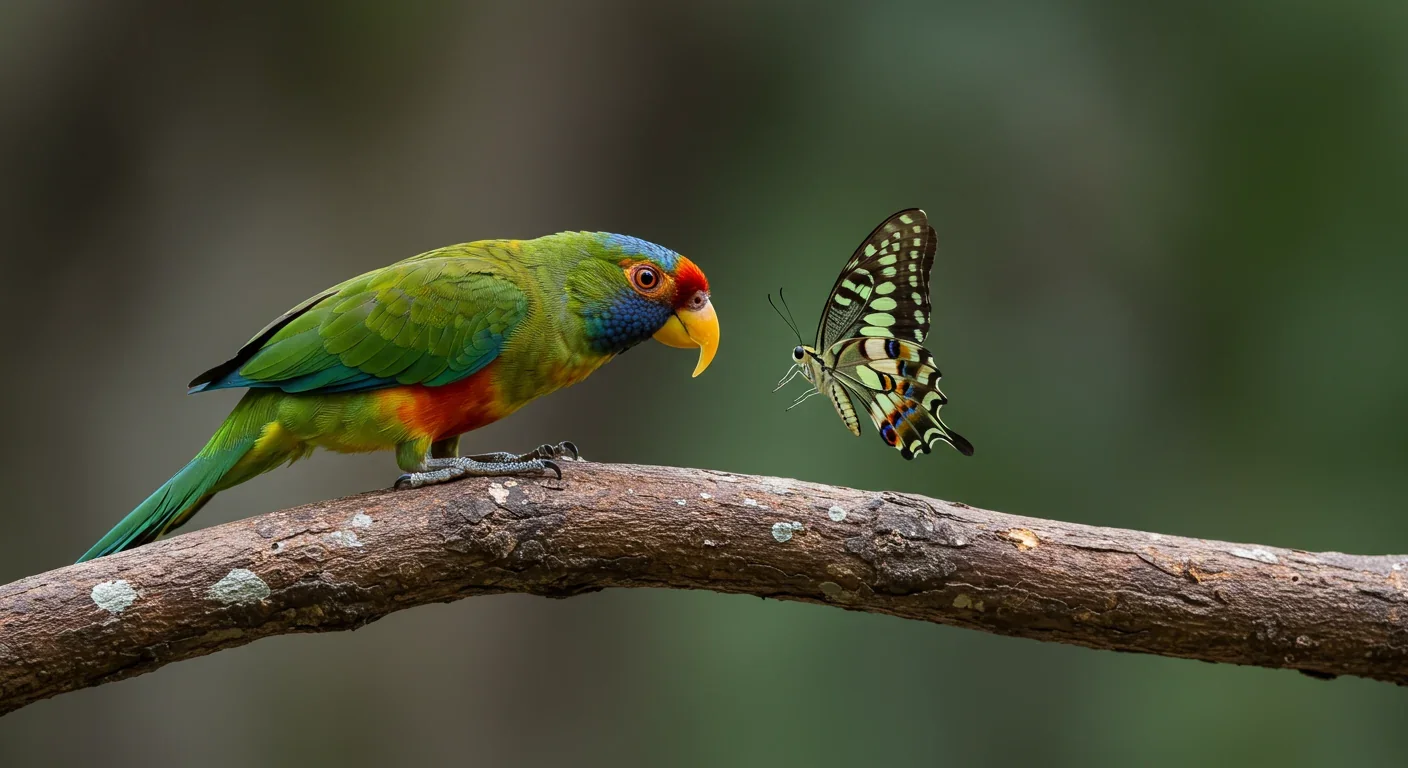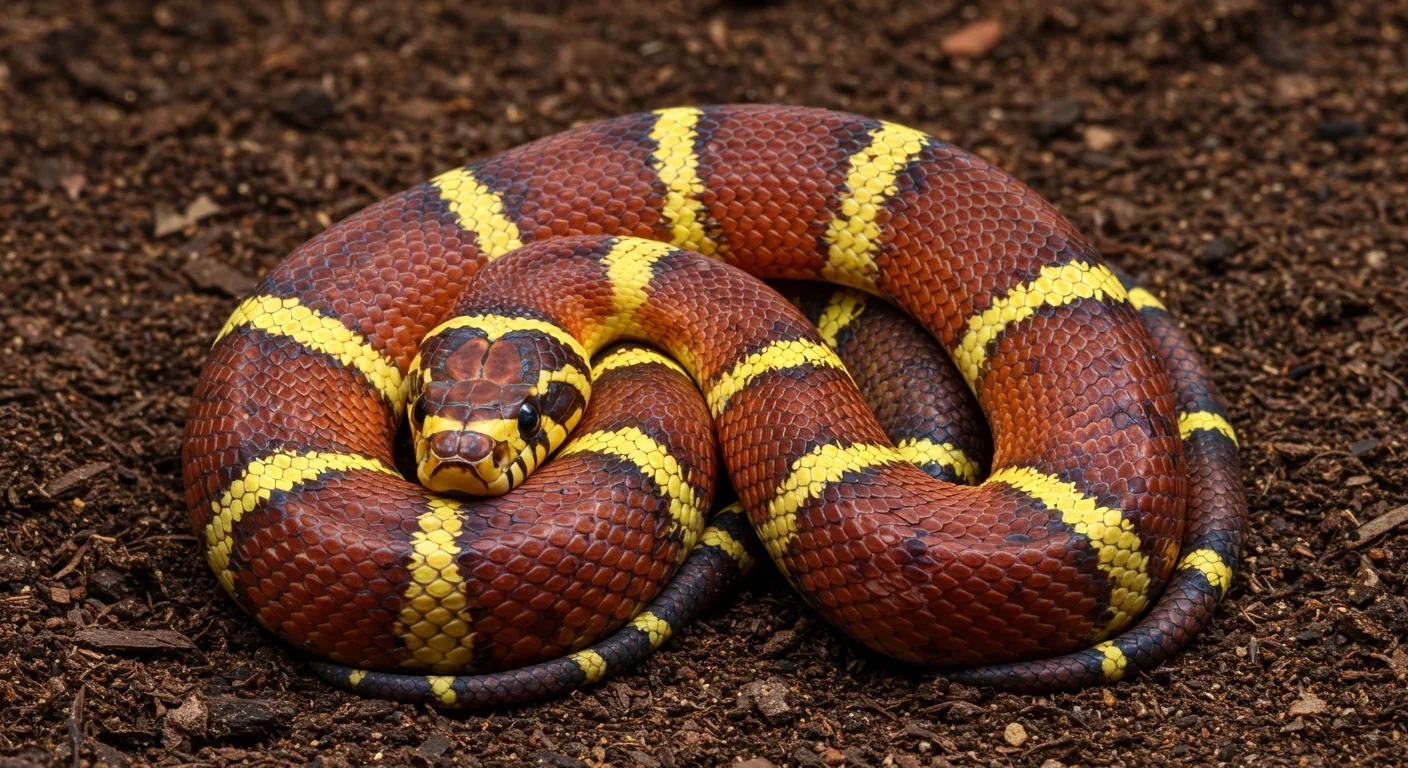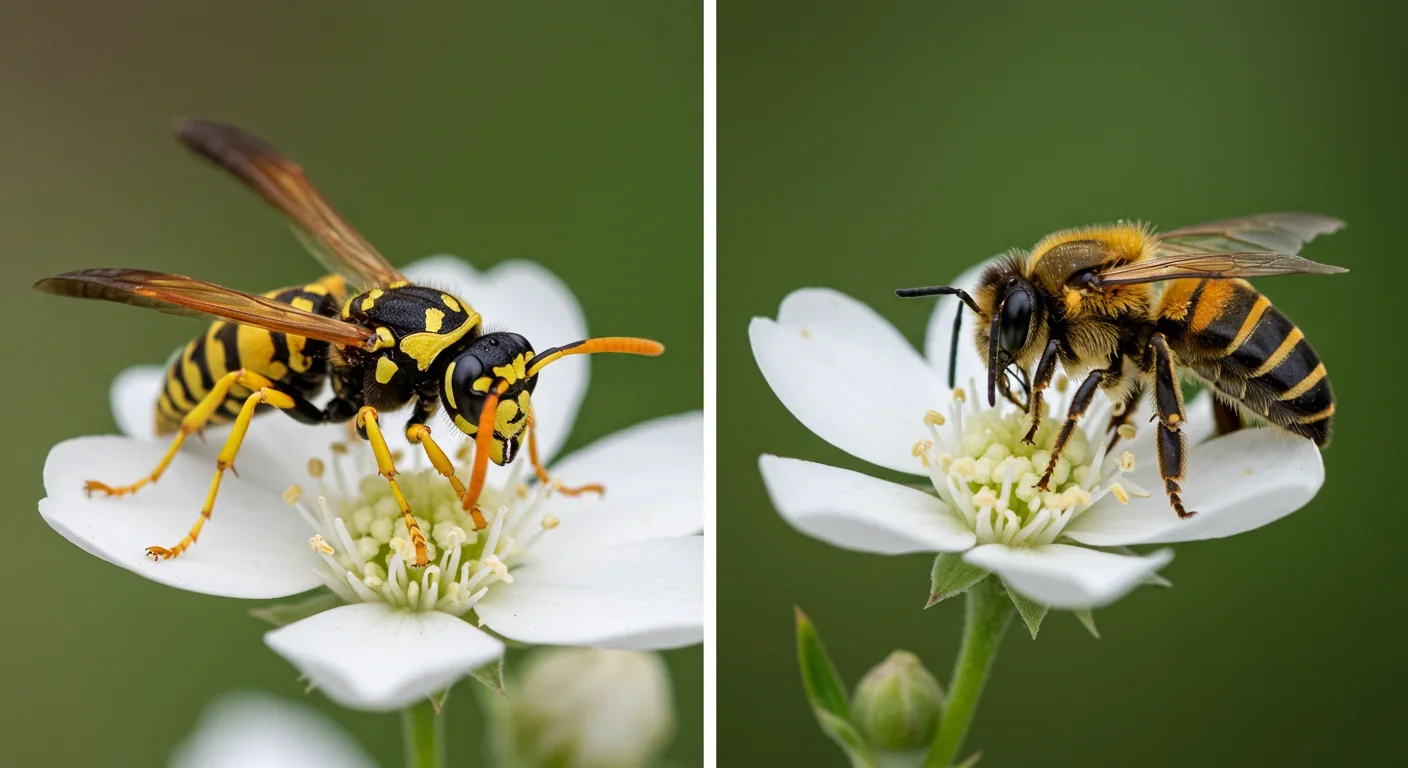Forest Biological Clocks: Ecosystems That Keep Time

TL;DR: Multiple unrelated species evolve identical warning signals, forming mimicry rings where collective deception protects everyone. This evolutionary phenomenon reveals how natural selection creates cooperation without intent, reshaping our understanding of survival strategies.

In the tropical rainforests of the Amazon, dozens of butterfly species have pulled off an evolutionary trick so sophisticated it's taken scientists decades to fully understand it. These insects don't just copy one dangerous model—they've formed what biologists call mimicry rings, where multiple unrelated species converge on identical warning signals to collectively deter predators. It's nature's version of safety in numbers, except the "safety" comes from looking equally dangerous, and the numbers can include species that aren't dangerous at all.
This isn't your typical evolutionary arms race between predator and prey. Mimicry rings represent something far stranger: a form of unspoken collaboration where species that never directly interact evolve to look remarkably similar because it benefits everyone involved. And the more researchers study these systems, the more they reveal about how natural selection can create order from chaos, turning individual survival strategies into complex networks of deception that span entire ecosystems.
The concept starts with a simple survival problem. If you're a toxic butterfly, you need predators to recognize you're dangerous. But here's the catch: every time a bird learns to avoid you, one of your relatives probably got eaten. That's a costly way to educate predators.
Müllerian mimicry solves this by having multiple toxic species share the same warning pattern. When a bird attacks any butterfly with red and yellow stripes, it learns to avoid all butterflies with that pattern. The cost of educating predators gets split among all participants. It's an honest signal—everyone wearing the pattern really is dangerous.
But nature takes this further. In tropical rainforests, researchers have documented mimicry rings involving dozens of species across completely different taxonomic groups. Butterflies mimic moths. Moths mimic beetles. And sometimes, harmless species slip into the ring, borrowing the protection without paying the cost.
Mimicry rings can involve anywhere from 2-3 species to over 20 completely unrelated organisms, all converging on the same warning pattern through independent evolution.
The Heliconius butterflies of Central and South America form some of the most studied examples. More than 10 species in a single region can share nearly identical wing patterns—black with red and yellow bands, or combinations of orange, yellow, and black. Each pattern represents a different mimicry ring, and membership isn't random. It's driven by which predators hunt in that area and what warning signals they've learned to recognize.
For mimicry rings to work, predators need to be smart enough to learn but not so smart they can tell mimics apart. Birds fit this profile perfectly. Studies show that predators like birds can learn to avoid warning patterns after just a few negative experiences.
This creates frequency-dependent selection, one of evolution's most elegant feedback loops. When a warning pattern becomes common, predators encounter it more often. Each encounter reinforces the lesson: avoid this pattern. The more species that share the pattern, the stronger and faster the learning becomes. It's a self-reinforcing system where being part of the crowd makes everyone safer.

But the system has limits. If harmless mimics become too common relative to truly toxic models, predators start encountering edible prey wearing warning colors. The lesson weakens. Attacks increase. The protection value drops for everyone in the ring. This is why Batesian mimics—harmless species copying dangerous ones—must stay rare compared to their toxic models.
The balance is delicate. Field work in tropical rainforests proves the system works: areas packed with mimicry relationships support 30% more butterfly species than areas without them. The collective deception enables biodiversity.
How do unrelated species end up looking identical? The genetic mechanisms behind mimicry rings reveal some of evolution's most creative solutions.
In Heliconius butterflies, researchers have identified specific genetic loci controlling wing patterns. Even more remarkably, the same genes get reused across different species to create similar patterns. It's convergent evolution at the molecular level—different species finding the same genetic answers to the same evolutionary question.
"Evolution doesn't create new genes from scratch; it repurposes existing ones for novel functions."
— Genetic Studies of Butterfly Mimicry
Some of these pattern genes are organized into supergenes: tightly linked clusters of genes inherited as a unit. In Heliconius numata, a single supergene controls the entire mimetic pattern. This allows the butterfly to switch between different mimicry rings with just one genetic change, like flipping a switch between different costumes.
The tradeoff is genetic diversity. Because supergenes suppress recombination, they can accumulate harmful mutations. But recent research shows that even small amounts of recombination within supergenes can purge these deleterious mutations, maintaining evolutionary flexibility without losing the coordinated pattern control.
In one fascinating case, scientists discovered that a gene called doublesex—originally involved in sex determination—was co-opted to control mimetic wing patterns in some butterflies. Evolution doesn't create new genes from scratch; it repurposes existing ones for novel functions. It's genetic recycling at its finest.

Walk from one valley to the next in the Andes, and you might find the same butterfly species wearing completely different warning patterns. This isn't random variation—it's geographic mosaic theory in action.
Different regions have different predator communities, different toxic model species, and different local mimicry rings. A butterfly species distributed across a wide geographic range can belong to different mimicry rings in different locations. Geographic races of Heliconius erato, for instance, vary dramatically in color pattern depending on which local models they mimic.
This creates what researchers call a geographic mosaic of coevolution: the evolutionary dynamics of mimicry vary across landscapes depending on local ecological conditions. Where one toxic species is common, the mimicry ring converges on its pattern. In a different region where that species is absent, the ring forms around a different model.
The Andes Mountains have been particularly important in shaping mimicry diversity. The mountain range acts as a barrier, splitting populations and creating allopatric speciation events. Different lineages on opposite sides of the mountains evolve different mimicry patterns in response to their local predator communities.
When new toxic species arrive in an area or predator communities change, mimicry rings can reorganize within decades—evolution in real time.
What's striking is how quickly these systems can shift. When new toxic species arrive in an area or predator communities change, mimicry rings can reorganize within decades. Field observations show butterfly mimics evolving better resemblance to new models within just a few generations. It's real-time evolution we can observe within human lifetimes.
Butterflies dominate the mimicry literature, but they're far from the only participants. Coral snakes and their mimics form some of the most recognized vertebrate mimicry rings.
The classic "red touches yellow, kill a fellow; red touches black, venom lack" rhyme refers to coral snakes and their mimics in North America. Multiple coral snake species share similar red-yellow-black banding patterns—a Müllerian mimicry ring of venomous snakes. Harmless milk snakes and king snakes have evolved to resemble them, joining the ring as Batesian mimics.

But vertebrate mimicry rings tend to be less diverse than invertebrate ones. The reasons likely involve body size constraints: larger animals have less flexibility in rapid pattern evolution, and their lower population densities make frequency-dependent selection weaker.
Wasps and bees provide another example. Vespid wasps and honey bees share black and yellow striped patterns across many species. Both groups have stings, making this a Müllerian ring. Harmless hoverflies mimic the pattern, benefiting from the protection without the weaponry.
The pattern repeats across the natural world: poison dart frogs in Central America, distasteful ladybird beetles, toxic sea slugs. Wherever warning coloration evolves, mimicry rings tend to follow. They represent convergent evolution's solution to a universal problem: how to advertise danger while minimizing the cost of educating predators.
Visual patterns dominate our understanding of mimicry because humans are visual creatures. But mimicry rings often operate across multiple sensory channels simultaneously.
Mimicry works through multiple senses—not just visual appearance but also sounds, chemical cues, electrical signals, and behaviors. Toxic butterflies don't just look similar; they often fly in similar patterns, making them equally recognizable to predators from movement alone.
Some researchers found that even color-blind predators can use luminance contrast to detect and learn from warning patterns. This means the evolutionary importance of contrast might exceed the importance of specific colors. A high-contrast black and yellow pattern works because it's easily detectable and memorable, regardless of whether the predator perceives the yellow as we do.
"The evolutionary importance of contrast might exceed the importance of specific colors—it's about being detectable and memorable, not necessarily beautiful."
— Predator Vision Research
Chemical signaling adds another layer. Many toxic species release defensive compounds that predators can smell or taste. When multiple species in a mimicry ring share similar chemical profiles, they reinforce the warning across modalities. A predator that tastes, smells, and sees the same signal learns faster and retains the memory longer.
This multimodal signaling may explain why some mimicry rings persist over long evolutionary periods. Single-modality mimicry might be easier to break, but when multiple senses confirm the warning, the protection becomes more robust.

Mimicry rings can be understood through evolutionary game theory—the mathematical framework for analyzing how different strategies perform when their success depends on what others are doing.
In a mimicry ring, your survival depends not just on your own defenses but on the defenses and abundance of everyone else wearing your pattern. This creates frequency-dependent selection: the fitness of a trait depends on how common it is in the population.
Mathematical models show that mimicry rings are evolutionarily stable under specific conditions. There must be sufficient predator overlap among participating species. The toxic species must be common enough to effectively educate predators. And any harmless mimics must remain rare enough that predators continue encountering defended prey more often than undefended ones.
The models predict tipping points. Below a certain density of toxic models, the mimicry ring collapses—predators don't learn the association strongly enough, and wearing the warning pattern becomes more conspicuous than protective. Above that threshold, the ring stabilizes, and selection favors convergence.
Interestingly, positive frequency-dependent selection can create a runaway effect. As a pattern becomes more common, it becomes more recognizable, which makes it more protective, which favors more species converging on it. This feedback loop can lead to the dominance of a particular pattern across an entire ecosystem.
Mimicry rings exhibit tipping points: below a certain density of toxic models, the entire system collapses and the protection disappears.
The game theory framing also explains why we see different mimicry rings in the same location. Each ring represents a different evolutionarily stable strategy—a different solution to the predation problem that works because enough participants use it.
Mimicry rings aren't permanent. They're dynamic systems that can shift or collapse in response to ecological changes.
When predator communities change, the selective pressures maintaining a mimicry ring can disappear. If a key predator goes locally extinct, the warning signals it learned become irrelevant. Species may drift away from the pattern, or new patterns may emerge.
Climate change poses a particular threat. As temperature and precipitation patterns shift, species distributions change. Toxic models may move to new areas, leaving their mimics behind. Or mimics may expand into regions where their models are absent, breaking the geographic correspondence that maintains the deception.
Human activities create more direct disruptions. Habitat fragmentation reduces population sizes and connectivity, making it harder to maintain the density of toxic models needed to educate predators effectively. Pesticide use can selectively eliminate certain species, breaking apart established rings.
There's also evidence that some mimicry rings are inherently unstable. If the fitness costs of maintaining a defensive pattern outweigh the benefits in a changed environment, selection may favor abandoning the ring. Researchers have documented cases where hitchhiking deleterious mutations linked to pattern genes impose fitness costs that can outweigh the protection benefits.
Step back from the butterflies and snakes, and mimicry rings reveal fundamental truths about how evolution works.
First, they show that cooperation can emerge without intent. The species in a mimicry ring don't communicate or coordinate, yet they achieve a form of collective action through shared selective pressures. It's large-scale inter-species cooperation that arises purely from individuals responding to their local environment.
Second, they demonstrate that evolution finds solutions at multiple levels simultaneously. The genetic mechanisms, the developmental pathways, the behavioral patterns, and the ecological relationships all evolve in concert to create functional mimicry. Natural selection operates as a system-level optimizer, not just a gene-level one.
"Mimicry rings showcase large-scale, emergent inter-species cooperation that arises purely from shared selective pressures, not from any direct mutualistic interaction."
— Evolutionary Biology Research
Third, mimicry rings highlight the importance of indirect effects in evolution. Your fitness depends not just on your direct interactions with predators but on the abundance and distribution of other species wearing your pattern, the learning psychology of predators you may never encounter personally, and historical patterns of who lived where generations ago.
This interconnectedness means that evolutionary outcomes are often contingent and path-dependent. If a different species had colonized an area first and established a different warning pattern, the entire mimicry ring might have converged on that pattern instead. Evolution doesn't find optimal solutions in an absolute sense; it finds locally stable solutions given the historical and ecological context.
Modern tools are opening new windows into mimicry ring biology. Scientists now use human perceptual grouping studies to define mimicry rings in taxa where traditional frequency-dependent models struggle. If humans can't reliably distinguish two patterns, predators probably can't either.
Genomic sequencing has revealed the molecular details of pattern evolution. Researchers can now trace exactly which genetic changes led to which pattern modifications, showing that mimicry evolution in groups like Adelpha butterflies proceeds via gradual accumulation of small stepwise changes rather than abrupt transitions.
Conservation implications are becoming clearer. Protecting mimicry rings requires thinking beyond individual species to consider community-level dynamics. Preserving a harmless mimic is useless if its toxic models go extinct. Management strategies need to maintain the ecological relationships and predator communities that sustain these systems.
Looking ahead, mimicry rings offer a natural laboratory for testing evolutionary theory. They're tractable enough to study in detail but complex enough to pose real challenges. Each new field site, each newly sequenced genome, each behavioral experiment adds pieces to a puzzle that's been millions of years in the making.
There's something deeply satisfying about mimicry rings. They represent evolution doing what it does best: taking a simple selective pressure and elaborating it into something complex, intricate, and beautiful.
A butterfly doesn't know it's part of a mimicry ring. It doesn't understand that its wing pattern protects it because dozens of other species share the same pattern, or that this convergence emerged from millions of individual selection events over countless generations. It just exists, looking the way it does because its ancestors who looked slightly different got eaten more often.
Yet from that mindless process, natural selection has created systems of exquisite sophistication. Mimicry rings are nature's version of a collaborative art project, painted in the language of genes and shaped by the psychology of predators. They remind us that the most creative solutions often emerge not from intelligent design but from the relentless iteration of variation and selection.
The next time you see a brightly colored butterfly or a banded snake, remember: you're looking at a participant in an evolutionary conspiracy that spans species, continents, and millions of years. You're seeing what happens when survival itself becomes a shared signal, a collective deception, a warning that saves lives precisely because everyone agrees to tell the same beautiful lie.

MOND proposes gravity changes at low accelerations, explaining galaxy rotation without dark matter. While it predicts thousands of galaxies correctly, it struggles with clusters and cosmology, keeping the dark matter debate alive.

Ultrafine pollution particles smaller than 100 nanometers can bypass the blood-brain barrier through the olfactory nerve and bloodstream, depositing in brain tissue where they trigger neuroinflammation linked to dementia and neurological disorders, yet remain completely unregulated by current air quality standards.

CAES stores excess renewable energy by compressing air in underground caverns, then releases it through turbines during peak demand. New advanced adiabatic systems achieve 70%+ efficiency, making this decades-old technology suddenly competitive for long-duration grid storage.

Our brains are hardwired to see patterns in randomness, causing the gambler's fallacy—the mistaken belief that past random events influence future probabilities. This cognitive bias costs people millions in casinos, investments, and daily decisions.

Forests operate as synchronized living systems with molecular clocks that coordinate metabolism from individual cells to entire ecosystems, creating rhythmic patterns that affect global carbon cycles and climate feedback loops.

Generation Z is the first cohort to come of age amid a polycrisis - interconnected global failures spanning climate, economy, democracy, and health. This cascading reality is fundamentally reshaping how young people think, plan their lives, and organize for change.

Zero-trust security eliminates implicit network trust by requiring continuous verification of every access request. Organizations are rapidly adopting this architecture to address cloud computing, remote work, and sophisticated threats that rendered perimeter defenses obsolete.